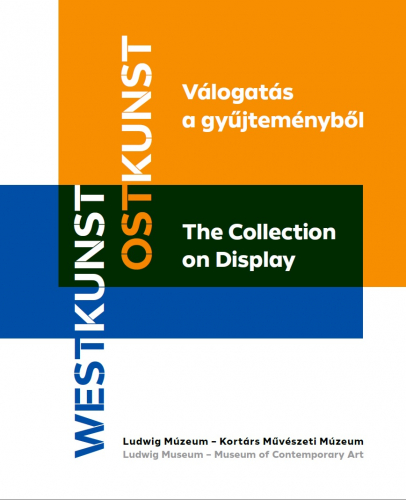
Rafael Y. Herman
The catalogue was published in conjunction with the exhibition, Rafael Y. Herman, held at Ludwig Museum - Museum of Contemporary Art, between 15 February - 1April, 2018.

The catalogue was published in conjunction with the exhibition, Rafael Y. Herman, held at Ludwig Museum - Museum of Contemporary Art, between 15 February - 1April, 2018.

The catalogue presents the exhibition in the Hungarian Pavilion at the 16th International Architecture Exhibition.

The newly organized permanent exhibition makes attempts to present emphatic points not only in well-organized chronological order or along stylistic features, but to examine the artistic-cultural parallels that can be found between Western and Eastern art despite the different social structures.

A special souvenir catalogue accompanies the exhibition which includes a comprehensive essay by the novelist and cultural critic Michael Bracewell.

Members of Pécsi Műhely were labouring on renewing local Constructivist and Avant-garde traditions, as well as developing a new visual language and establishing a new visual culture.

The catalogue presents the exhibition of Gyula Várnai in the Hungarian Pavilion at the 57th International Art Exhibition of La Biennale di Venezia.

The catalogue presents the exhibition of Gyula Várnai in the Hungarian Pavilion at the 57th International Art Exhibition of La Biennale di Venezia.

The exhibition reflects an ongoing collaboration between the National Gallery of Arts and Ludwig Museum – Museum of Contemporary Art, Hungary.The selection, which includes some of the best known contemporary Hungarian artists such as László Fehér, László Lakner, Dóra Maurer, Sándor Pinczehelyi an

Founded in 1971, the Makó Artists’ Colony is a special site in the history of Hungarian graphic art. Its main profile comprised photo-based silk screen and offset printing.

A selection of contemporary positions from the art scenes of Albania and Kosovo.

"The picture is not about something else: without circumlocution, it declares itself.” – states Gábor Záborszky.

Had he not passed away unduly young, Zoltán Érmezei would be sixty years old now. His lifework is less known for the wider public, although he was an outstanding member of the alternative artist generation in the 1980’s.

The art collection brought together by Peter and Irene Ludwig is the foundation of all Ludwig Museums. Perhaps the most well-known and famous part of this collection is the body of artworks that represents the period of Pop Art.

In the spring of 2015 the Ludwig Museum – Museum of Contemporary Art organised a comprehensive as well as gap filling exhibition of Vilmos Zsigmond’s photographic life-work.

Ernő Tolvaly, an enigmatic figure of Hungarian art life, is primarily known for his artistic activity involving painting. In spite of his quiet personality, he exerted an influence on his colleagues as an artist, an organizer and a teacher, from the 1970s until his death in 2008.

Catalogue of the Ludwig Museum’s collection display in year 2012. The exhibition concept derives from the dual role of the Artist, i.e. the dialectic phenomena that artists are often both the creators and the main characters of their own works.

Painter Judit Reigl was born in 1923 in Kapuvár, and has been living and working in France since 1950. She is one of the rare artists of Hungarian origins, who is recognised in the United States, and whose oeuvre uniquely combines the traditions of European and American abstraction.

In his famous book Caught by History: Holocaust Effects in Contemporary Art, Literature, and Theory (1997), Dutch literary theorist Ernst van Alphen raised the question of the Holocaust’s artistic representability and introduced the notion of “Holocaust effect”.

Three selected artistic experiences are merged, that of Oleg Kulik, Josip Vaništa and the Blue Noses Group, by their common ground: the attitude towards dramatic events in the social domain.

Antal Lakner is a member of the Hungarian artist generation emerging in the 1990’s many of whom, including him, have achieved international recognition.

“All sound is nearly akin to Silence; it is a bubble on Her surface which bursts straightway, an emblem of the strength and prolificacy of the undercurrent” – writes Thoreau, an idea that was also crucial for John Cage who deliberated sound from all musical constraints, and this freedom of the so

Gábor Ősz's art deals with questions of pictorial depiction and photography. Beside analyzing technical problems, light, perception and possibilities of the camera, he questions the basic function of the photograph, the exact depiction of reality.

Photorealism is not merely a genre of painting that invites competition with photographic depiction, but a portrait of welfare society, and sometimes an enlarged image of the tiny lines on its face.

Working in a realm that is defined by the overlapping fields of painting, sculpture and architecture, János Megyik (1938, Szolnok) has built an œuvre that concentrates on modelling the structure of the panel painting.

The artists who practiced institutional critique in their art in the 1960s and 1970s consciously created works of art that are not marketable or easily museologized. It is a paradoxical situation that, most of these works are in museums by now.

An illustrated brossure in Hungarian about the works of László Moholy-Nagy with three essays, a detailed CV of Moholy-Nagy, and black and white photographs. Published on the occasion of the László Moholy-Nagy. The Art of Light exhibition at the Ludwig Museum.

The catalogue of Sing! - Mladen Stilinović Retrospective exhibition. Throughout his diversified work, Stilinović explores ideological signs and their social aspects.